I’ve been asked to write about our experiences (plus some plant info!) on our recent trip to India. Our third visit to India (it won’t be the last) and each time somewhere different – this time it was a February trip to Assam first for just over a week and then down south to Tamil Nadu and Kerala.
Wow – if you haven’t visited Assam, get there soon. We had briefly passed through on our way to Bhutan in 2010 (that’s another story!), but this time visited 3 wildlife game parks and spent 3 nights/4 days cruising the Brahmaputra River. Google: Assam Bengal Navigation. It has to be one of the best ‘trips within a trip’ that we’ve ever done.
Back on land what struck us was that it was really cold at night, particularly at Manas Game Park on the Bhutan border but this aside, it is definitely the best time of the year to visit as the grasses are lower and the river is navigable. Take your winter woollies for Manas – seems odd for India but go prepared. There are massive tea estates in the west – shaded by Grevillea robusta, the Silky Oak and sometimes jacaranda which all had a ‘sleeve’ of peppercorn vines coating the trunks. We saw quite a bit of wildlife in the fabulous Kaziranga National Park further east (one horned rhino, elephants, deer, wild pig and a host of incredible birds including the giant hornbill) plus plenty of interesting wooded forests and open savannah-like plains covered in the ubiquitous tall elephant grass.

At Kaziranga NP. At this moment, I didn’t know the rhino would cross the swamp later that day!
The most striking tree in Kaziranga was the Bombax ceiba – the ‘red silk cotton tree’ which at this time of the year is deciduous and many were in full scarlet flower. The trunks are generally ramrod straight with whelk-like spurs and then a tall spreading canopy. Elephant and Jeep rides are the way to get around the various sections of Kaziranga and if you are a bit light on rear padding, take a blow up cushion to go on an elephant ride because you sit astride and for 2 hours it can become more than a little uncomfortable!
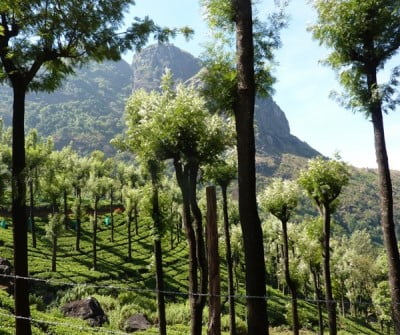
Silky oak, Grevillea robusta, shades tea plantations in Assam, northern India
From the wilds and relative peace, quiet and beauty of Assam, down to the vibrant, hot, noisy and colourful southern states of Tamil Nadu, Kerala and Karnataka. Back to coconut palms and rice paddies – all through Tamil Nadu and across to Kerala. It was very sad to see the destructive force of the cyclone that had ripped through Pondicherry (on the east coast and south of Chennai/Madras) some 7 weeks prior. Although buildings were unaffected, massive 100+ year old trees were uprooted in the botanical gardens plus many palm trees snapped off – these usually seem to withstand pretty fierce winds.
Two public gardens of note down south were the Botanical Gardens in Ootacamund (Ooty) in the Nilgiri Hills and the Lal Bagh Gardens in Bangalore. Firstly – the gardens in Ooty that were established in 1847 by the Marquis of Tweedale. This is a hill station garden at an altitude of 2,250m resulting in an interesting mix of plants in the 55 acre gently sloping site that is only about 10 minutes walk from the quaintly and very British named ‘Charing Cross’!! Conservatories, an Italian garden, rose garden and many really mature trees amongst which it was good to see stately araucarias, eucalypts plus massive multi-branched purple Cordyline australis, rhododendrons, camellia japonicas and lots of annuals, the favourites being red salvia, impatiens and marigolds. There was also an impressive map of India planted out with succulents. This is a park for everyone and it was full of families enjoying the sunshine on the sloping lawns beside signs urging people to stay off the grass!

Botanical Gardens (est. 1847) in Ootacamund (Ooty)
On the way to Ooty we had stopped at the Floriculture Centre in Munnar which is part of the Kerala Forest Development Corporation. Set on a very steep sloping hillside, we called in on a Sunday – very popular and we had to pay to enter. Every type of cool climate annual you can image was growing there all neatly labelled and no sign of disease or pest problems at all. Many annuals are grown in clay pots in a soil mix is just that – dirt! They seem to thrive!
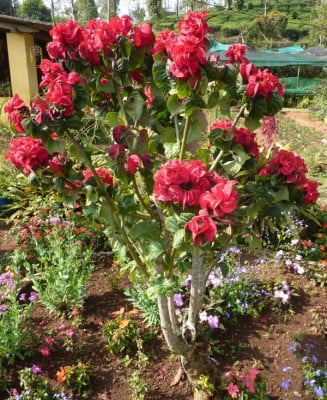
Colourful double poinsettia at a little grower’s nursery in Kerala
Being a fan of Monty Don’s Around the World in 80 Gardens, we managed to see two in this region. Well one actually as we weren’t allowed in to the magnificent Old Railway Garden at Munnar station (disused now) – had to satisfy ourselves with peering over the fence to see immaculate terraces full of lupins, hollyhocks, asters, larkspur and so on.
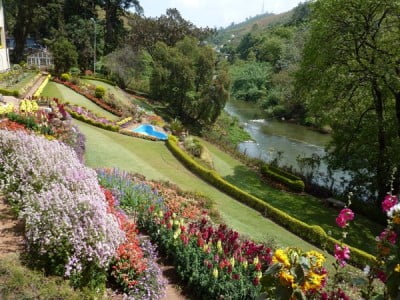
Old railway garden at Munnar station
But we did call in at Abrahams Spice Garden in Thekkady a few days earlier. A scruffy place but all the spices you ever wanted to see in one small plot – cardamoms, vanilla, pepper, cocoa (I know it’s not a spice!) and many more fascinating plants including a variety of lemon that had fruit over 30cm long!
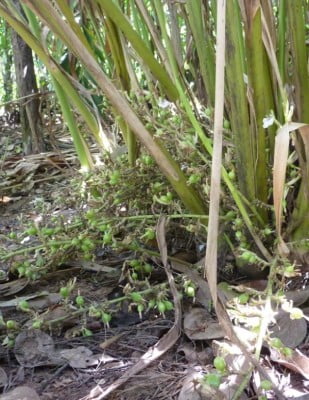
Cardamom growing at Abrahams Spice Garden in Thekkady
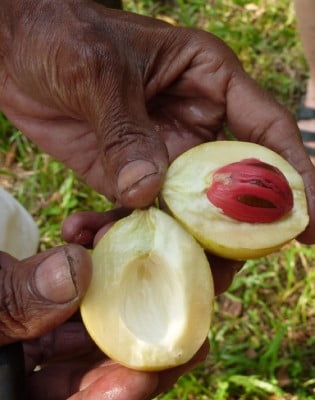
Mace and nutmeg at Abrahams Spice Garden
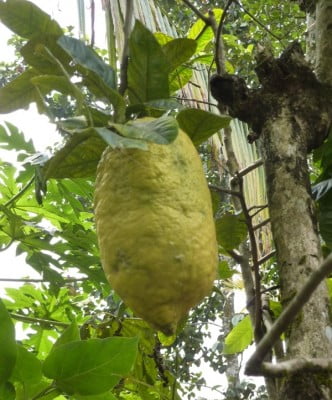
Amazing 30cm long lemon fruit at Abrahams Spice Garden
The other major garden as mentioned was the Lal Bagh Gardens in Bangalore, our last stop and probably a place most people think of as being all about IT and call centres. Well, I think it is and it is a city that is rapidly and massively changing with a totally chaotic traffic system. Nevertheless, we found our way to the gardens and took an electric buggy around the impressive 240 acre grounds with an excellent driver/guide. There was no way we were going to walk it in the heat!
It is a public garden full of incredible trees. Don’t go there if you want beds full of annuals, although there are some near the Crystal Palace styled glasshouse and the ever colourful cannas and bougainvilleas grace the entrance to the site. It is the trees however that dominate. There is a massive White Silk Cotton Tree, Ceiba pentandra with the largest buttressed trunk that I’ve seen; many beautiful Tabebuia argentea – the golden bell tree in full bloom with brilliant sulphur yellow flowers including the one planted by Pandit Jawaharlal Nehru in 1956. Also huge clumps of the thickest and tallest bamboo you can imagine plus a really interesting tree – Krishna’s Buttercup – Ficus ‘Krishnae’ with intriguing cone/cup like leaves (to hold the butter that the god Krishna so loved) and with thick aerial roots that had formed several other trees. Also the wonderful pink and white tasselled flowers (like something you would see at the Moulin Rouge) of the Bombax Tree – Pachira insignae – stunning.
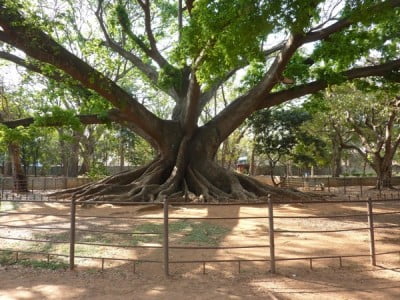
Huge, spreading buttress trunk of the white silk cotton tree, Ceiba pentandra
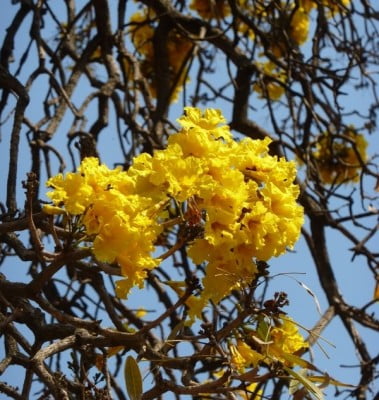
Golden bell tree, Tabebuia argentea in full bloom

Ficus ‘Krishnae’, called Krishna’s buttercup for the folded leaves in which Krishna held his butter

Tasselled pink flowers of the Bombax tree – Pachira insignae
It must be noted that I am not a botanist and there may well be errors in the tree descriptions but I have gone on signage supplied and my notes. Anyway – take a trip there – it’s so well worthwhile.
I don’t go on these trips specifically looking for points of horticultural interest – would not have lasted 39 years of marriage had I done so but we do pop in to places that look exciting and every plant place we stopped at offered something completely different – as only India can do!
I’m an ardent advocate of India – it can be incredibly frustrating at times but if you go with an open mind and a smile, the rewards will be fantastic. Throughout our sub continental travels we’ve been met with warmth and hospitality and even if you may not be a cricket aficionado, talk about the game – it’s a passion that goes way beyond anything we see here and it certainly is a cultural barrier breaker.
